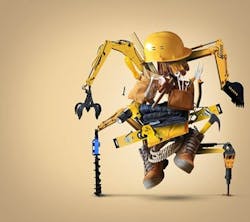Five Technologies to Make Construction Safer
The complex nature of construction sites means they can be a health and safety nightmare—electric cables, workers on foot, machines and people working at height, and the movements of multiple machines on the ground.
But coming to the rescue is a technology-driven safety revolution, with advances being made every day. Courtesy of Volvo, here’s a look at the ways in which innovations are helping to make construction sites safer.
1. Boost manpower with robotics
In the old days, only strong men were thought to be able to work in construction. But even tough guys can trigger painful muscle damage from lifting heavy tools, and construction is a major offender with the rate of work-related musculoskeletal disorders 16 percent higher than in any other industry. But as automation takes off, robots are now being employed on sites to do the heavy lifting. Where once it would take six or seven workers to carry a 440-pound reinforcing rod, for example, Japanese constructor Shimizu has invented a robotic arm to take the load. This machine aims to do the job in half the time with half the effort while cutting the risk of worker injury.
Robots can also be tasked with handling hazardous materials or entering dangerous work zones under the watchful eye of a human supervisor. Also in Japan, a team of researchers has created a rescue robot, a hydraulic technology that, once fully developed, could be deployed on construction sites to fully assess a dangerous situation.
2. Stay connected and avoid falls
Slips and trips are the most common source of injury on many construction sites in the U.K., causing a third of accidents. Meanwhile, across the pond, a sobering 40 percent of fatalities on site are caused by tripping or falling. Prevention is key: keeping walkways clear of obstructions, ensuring all structures are in good working order, putting equipment away after use, and wearing PPE will help keep workers on their feet. Clever technology such as the Spot-r Clip, which can simply attach to a belt, records any trips and immediately alerts supervisors. Just a push of a button will also report a hazard without anyone having to leave the site. With a third of workers concerned that safety takes a backseat to productivity, tech like this is proving that the two are no longer mutually exclusive.
3. Keep it down!
Construction workers are exposed to high levels of noise on an almost daily basis, triggering hearing problems ranging from mild tinnitus to disabling deafness. Not only that, but exposure could also affect workers’ mental health. As a comparison, an office environment may range from 40 to 50 dB(A), whereas construction sites endure levels considerably greater, with 90 dB(A). Given that a minor adjustment of just 3 dB(A) is noticeable to human ears, excessive noise can be a huge problem. Technology such as noise cancelling headphones has been available for years, but innovations are continuing to be developed. Companies like Volvo are working on prototype electric machines that would produce 10 times lower noise levels.
4. Reach new heights with mobile apps
While surface trips are the most common cause of injury, falling from a height is the most common cause of death in the U.S. And with falls from ladders costing the nation $24 billion a year in work loss and medical bills, the safe and proper use of equipment when preparing to work at heights goes a long way to reducing accidents. Telematics like the NIOSH Ladder Safety App provide visual and audio cues to help workers know exactly when their ladders are positioned at the safest angle of 75.5 degrees. It also allows for more precise inspections of the ladder and provides tips for planning the task at hand.
5. Arm workers with vibration-busting tech
One of the most overlooked threats to construction workers is hand-arm vibration syndrome, with about 1 million U.S. workers said to suffer from the condition. It’s also estimated that 10 percent of workers will show symptoms after 12 years of consistent exposure. Caused by the prolonged use of power hand tools, which damage the blood vessels and nerves, it’s an incurable condition that can only be combatted through prevention. Wearable technology, however, can help reduce the risk. Monitoring bands such as HAVWEAR keep a record of a worker’s day-to-day activity and highlights when they are at risk of exposure, allowing a supervisor to make adjustments on the ground. The added benefit is that productivity is increased in comparison to more traditional methods of data tracking.
